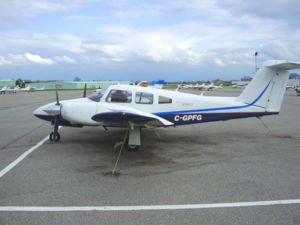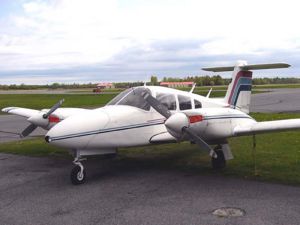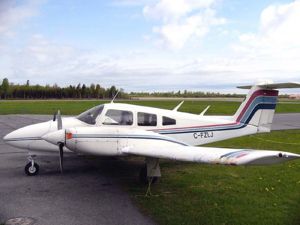PlaneSpottingWorld welcomes all new members! Please gives your ideas at the Terminal.
Piper PA-44 Seminole
The Piper PA-44 Seminole is essentially a twin-engine version of the popular Piper Cherokee series of small, single-engine flight training aircraft. Like its single-engine counterparts, it is primarily used for twin-engine flight training. It was built in 1979-82, in 1989-90, and again since 1995.
The Seminole is equipped with two 180-hp (135 kW) Lycoming engines, and it is often complained that the aircraft is greatly under-powered, especially for engine-out training (leading to the affectionate and awkwardly-rhyming moniker "No-Go Seminole" to some). However, the Seminole's single-engine performance is similar to that of many other popular light twins. A version built in 1981-82 featured turbocharged 180-hp (135 kW) Lycoming engines, which offer a significant improvement in performance at high density altitude.
The aircraft makes an effective multi-engine trainer, as the propellers are "counter-rotating" (with the left propeller rotating right and the right propeller rotating left), thus eliminating the critical engine and making the aircraft more controllable in the event an engine needs to be shut down or fails.
Other than having two engines, it is further distinguished from the majority of the Cherokee trainer line in having a high T-tail; in this, it is similar to the Arrow IV. This design is highly similar to the Beechcraft Duchess.
Operators
The PA-44 is used for multi-engine training by Bridgewater State College, Florida Institute of Technology, Bowling Green State University, Lewis University, Middle Tennessee State University, Kent State University, Minnesota State University, Mankato, Daniel Webster College, Western Michigan University, Embry-Riddle Aeronautical University, University of North Dakota, Sault College, Purdue University and FlightSafety International Academy in Vero Beach, Florida, University of Illinois - Institute of Aviation, Parks College at Saint Louis University.
Specifications (PA-44-180 Seminole)
General characteristics
- Crew: one pilot
- Capacity: 3 passengers
- Length: 27 ft 7 in (8.41 m)
- Wingspan: 38 ft 6.6 in (11.77 m)
- Height: 8 ft 6 in (2.59 m)
- Wing area: 184 ft² (17.1 m²)
- Empty: 2,360 lb (1,070 kg)
- Loaded: lb ( kg)
- Maximum takeoff: 3,800 lb (1,723 kg)
- Powerplant: 2x Lycoming O-360-A1H6, air cooled, direct-drive, horizontally opposed 4 cylinder engines, rated at 180 hp (135 kW) at Sea Level.
- Propellers: Two, 2-bladed, constant speed, fully feathering Hartzell HC-C2Y(K,R)-2 CLEUF with pitch controlled by oil/nitrogen pressure.
- Fuel: 2 main nacelle tanks each of 55 U.S. gallon capacity each (110 U.S. Gal. total), 2 U.S. gallons unusable.
Performance
- Maximum speed: 194 mph (311 km/h)
- Range: 1,000 miles (1,630 km)
- Single Engine Service ceiling 3,800 ft
- Service ceiling: 15,000 ft
- Absolute ceiling 17,100 ft (5,213 m)
- Rate of climb: 1,200 ft/min (366 m/min)
- Wing loading: 21.1 lb/ft² ( kg/m²)
- Power/Mass: 10.55 hp/lb ( kW/kg)
Related content
Related development: Piper Cherokee
Comparable aircraft:
Designation sequence: PA-34 - PA-39 - PA-40 - PA-42 - PA-44 - PA-46 - PA-48 - PA-60
Civilian:
E-2 ·
F-2 ·
G-2 ·
H-2 ·
J-2 (Taylor) ·
J-2 (Piper) ·
J-3 ·
J-4 ·
J-5 ·
PA-6 ·
PA-7 ·
PA-8 ·
PA-11 ·
PA-12 ·
PA-14 ·
PA-15 ·
PA-16 ·
PA-17 ·
PA-18 ·
PA-20 ·
PA-22 ·
PA-23 ·
PA-24 ·
PA-28 ·
PA-30 ·
PA-31 ·
PA-31T ·
PA-32 ·
PA-32R ·
PA-34 ·
PA-36 ·
PA-38 ·
PA-39 ·
PA-40 ·
PA-42 ·
PA-44 ·
PA-46 ·
PA-60 ·
PiperJet
Military: AE · C-83 · HE · L-4 · L-14 · L-18 · L-21 · LNP · NE · O-59 · PA-48 · TG-8 · U-7
Lists relating to aviation | |
|---|---|
| General | Timeline of aviation · Aircraft · Aircraft manufacturers · Aircraft engines · Aircraft engine manufacturers · Airports · Airlines |
| Military | Air forces · Aircraft weapons · Missiles · Unmanned aerial vehicles (UAVs) · Experimental aircraft |
| Notable incidents and accidents | Military aviation · Airliners · General aviation · Famous aviation-related deaths |
| Records | Flight airspeed record · Flight distance record · Flight altitude record · Flight endurance record · Most produced aircraft |



